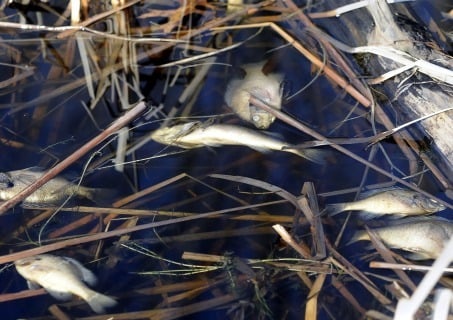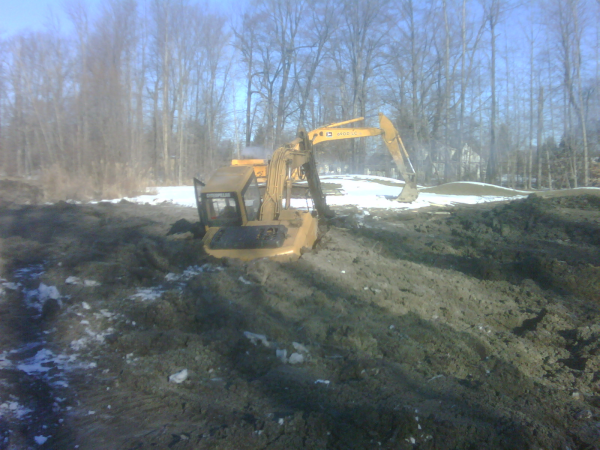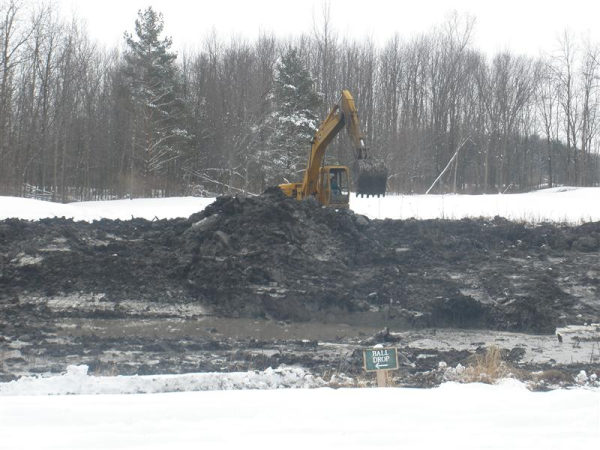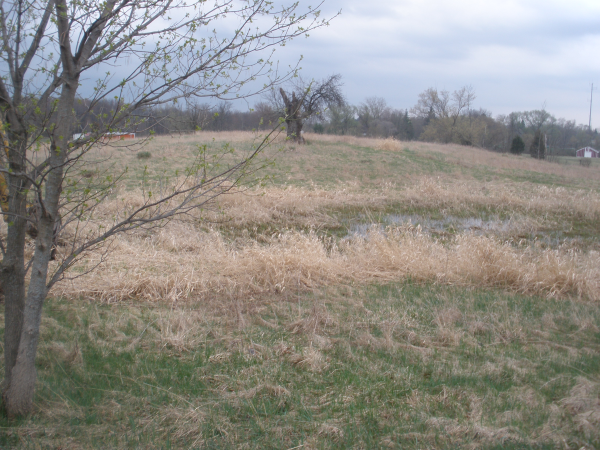
A pond may serve other useful purposes such as meeting critical water
needs during a drought, irrigating the garden or orchard, watering
livestock, or even fire fighting. There are intangible benefits such as
enjoying wildlife drawn to small bodies of water.
You don't have to own a large tract of land to consider building a pond.
Of the 15 million ponds already in existence in America, the average size
is only 1/2 acre. It may not sound like much, but our own 1/2-acre pond
is approximately 75 feet wide by 200 feet long, and with an average depth
of eight feet it contains more than a million gallons of water!
The particular pond size you decide on however, probably won't be
dictated by how much money you can afford to spend. Rather, it will hinge
almost entirely upon the lay of the land, the composition of the soil and
underlying strata, and the general suitability of the terrain for
impounding water. These factors dictate what type of earth-moving
equipment will be required to build the pond and the number of hours
needed. As a result of varying terrain conditions, it's possible one
landowner may have to spend only $3,000 to build a five-acre lake while
his neighbor has to cough up $6,000 for only a 1/1-acre pond.
Since the construction of even a small pond can be expensive, legions of
landowners have attempted every imaginable shortcut to reduce costs and,
predictably, horror stories abound. In northern Ohio, for example, a
landowner came up with a not-too-bright answer to shelling out for an
engineer to draw up blueprints and a contractor to do the 'dozer work. He
simply designed his own dam, borrowed a friend's D-6 Caterpillar, and
pushed the dirt into place. The resulting six-acre lake was a beauty for
several years. Then one spring, excessive rainfall raised the pond level.
The spillway couldn't handle the additional water and the makeshift dam
collapsed, sending a torrent of water cascading down a narrow valley. The
flood drowned 20 dairy cows on a neighboring farm, and ruined a barn on
another. Today, five years later, lawsuits are still pending against the
pond-builder.
In another case, this time in Kentucky, a landowner did not follow the
advice of a soil analyst who had warned that the compaction of red clay
in the pond basin would block water seepage. The landowner saved $2,000
but he now has a "dry" pond. When it rains the pond fills up, but several
days after the rain subsides the water begins percolating down through
the soil as if it were a sieve, until nothing remains but a hole in the
ground.
So, the strongest advice I can give anyone contemplating building a pond
is to forget about the one-time expense and foster a determination to do
the job right. Such an approach will undoubtedly prove the least
expensive. And it will result in a pond that is aesthetically pleasing,
safe, sound, and in full compliance with the laws that govern the
impounding of large quantities of water on private property.
That last aspect is critically important to any pond-owner. If a
professional engineer designed the pond and it received approval from one
or more government agency, it's just like having insurance. What I mean
is, if something should go wrong in the future and there is damage to
life, limb, or property, it's not likely you will be held liable.
One way to build a pond on your property is to hire a private engineering
firm that specializes in pond construction. They'll handle everything
from initial site examination to surveying, preparation of blueprints,
and supervision of numerous subcontractors. However, you should know in
advance that this is the most expensive route to take.
The second option, and the one I recommend, is to contact your local Soil
Conservation Service (SCS) office. This is a division of the U.S.
Department of Agriculture and every state has numerous regional and
county offices. Of the many responsibilities charged to SCS offices, one
is supervising the technical aspects of private pond construction.
The SCS will not pay for any of the construction costs, nor will it do
any of the actual work. It will handle all of the professional planning
you'd otherwise pay a stiff fee to have a private engineering firm do.
This includes site examination, soil analysis, surveying, blueprints,
pond and dam specifications, and specifying materials.
With blueprints and specs in hand, you can then contact a local
contractor to begin work. Don't worry if you don't know how to read
blueprints, interpret materials specifications, or anything pertaining to
soil chemistry and pond construction. Your contractor will know these
things, and your SCS official will be on location virtually every day to
oversee operations.
Ponds can be almost any shape, but most are rectangular, round, oval,
triangular, or teardrop-shaped. In flatlands, a large depression is
sometimes scooped out to form the pond basin, and the dam--if there is
one--surrounds the pond. More commonly, an earthen dam is placed between
steep hillsides and the water backs up and inundates a ravine or valley.
As to where the water comes from, the most common sources are surface
springs, underground aquifers, streams, surface run-off from higher
ground, or a combination of these.
A contractor's initial work is to scalp the pond site of its six or eight
inches of valuable topsoil and pile it somewhere for later use. Then,
with stake flags outlining the high-water mark of the pond-to-be and the
centerline of the future dam, dozers begin grading the pond basin to
remove all "refusal" (rock, shale, coal blossom, and unwanted soil types)
until sufficient pond depth is achieved.
A critical aspect of any pond's construction is sealing the basin to
prevent water from escaping and building the dam so that no water leaks
through. This involves dozers pushing thousands of tons of clay into the
pond basin from a nearby "borrow" area, determined from previous soil
test samples. If clay is absent in your region, your contractor may have
to haul truckloads of bentonite to the site at considerable expense.
(Bentonite is a volcanic material that is disked into the soil of the
pond basin; when wet, it swells to several times its original volume and
creates a water-tight seal.)
The dam is created by dozers carving out a T-shaped trench 10 feet deeper
than the deepest part of the pond basin. Layer upon layer of clay or
bentonite is then pushed into place six inches at a time and compacted
with a sheepsfoot roller.
When the dam is two-thirds complete, the spillway system is installed.
It's simply a length of steel pipe running through the dam structure that
allows excess water to escape. Without it, the water level would continue
to rise until it began rushing over the top of the dam, which would cause
serious erosion.
Next is the installation of a toe drain, a length of perforated plastic
pipe that runs through the back side of the dam to collect moisture and
drain it away. Keep in mind that the front of the dam, against the pond
water, is always wet. The toe drain ensures that, should water somehow
begin seeping through the compacted clay, it would not saturate all the
way to the back and undermine the dam's strength.
Finally, an emergency spillway must be built. This is a narrow channel
shooting off one side of the pond that takes over if the steel spillway
becomes clogged or if excessive rainfall is more than it alone can
handle.
When the lake basin and dam are completed, the contractor retrieves the
tons of topsoil that were set aside and carefully grades it over the dam,
around the shorelines, and over the borrow area. Following this, all bare
ground is limed, fertilized, seeded, and mulched to get the dam and
shorelines vegetated as soon as possible to prevent erosion.
All that is left to do now is to wait patiently for the pond to fill with
water, which takes from two months to a year depending upon the size of
the pond, the amount of rainfall, and the productivity of feeder streams
or springs serving the pond.
At this time your SCS office will bow out of the picture. They'll
recommend that you contact your state department of natural resources for
advice on stocking the pond with fish and for a free booklet describing
proper pond management techniques. Stocking your pond is accomplished in
two ways. If legal in your state, you can catch fish at local lakes and
transport them home in a makeshift tank (I used an old camping cooler
fitted with an aerator). Or you can buy fish from a hatchery; your
department of natural resources will supply names of local vendors.
The most compatible species are largemouth bass, channel catfish,
bluegills, and redear sunfish. The most widely accepted ratio is 100 bass
to 500 panfish per surface acre of water. At all costs, do not introduce
white or black crappies, rock bass, bullheads, or the largest predator
gamefish (northern pike or muskies, for example) into your pond. They
will present serious problems in time.
Your fish must have something to eat, so an ecologically sound food chain
should be established. Pond-management handbooks suggest applying
fertilizer to the water, which gives birth to algae bloom and plankton.
These microscopic food items serve as forage for the tiniest insects,
crustaceans, and minnows, which in turn become prey to bass, and panfish
fry, and fingerlings, which then feed larger panfish and bass.
If you want your fish to achieve the most rapid growth rates possible,
you can supplement their natural forage by stocking either golden shiners
or fathead minnows that are one to four inches long. The recommended
amount is 400 minnows per surface acre per year. Always purchase these
baitfish from a commercial supplier who ensures species
purity--attempting to seine minnows from a nearby creek may inadvertently
introduce an undesirable species such as carp or suckers.
According to biologists, a well-managed pond should support a harvest of
20 pounds of bass and 80 pounds of panfish per acre per year. It is
important the panfish be harvested because they reproduce so rapidly that
their numbers will otherwise throw the natural food chain out of balance.
In such cases, all fish inhabiting the water will suffer food shortages
and stunted growth.
If you neglect to heed the advice of qualified pond specialists, your
pond-building experience may be pure misery. But follow their sage advice
to the letter, plant a few evergreens around the shoreline, add a picnic
table as the final touch, and you'll have a little chunk of heaven



 This
This 
 Koi Clay (Bentonite)
Koi Clay (Bentonite)
-resized-600.jpg)
-resized-600.jpg)
-resized-600.jpg)
 A pond may serve other useful purposes such as meeting critical water
A pond may serve other useful purposes such as meeting critical water